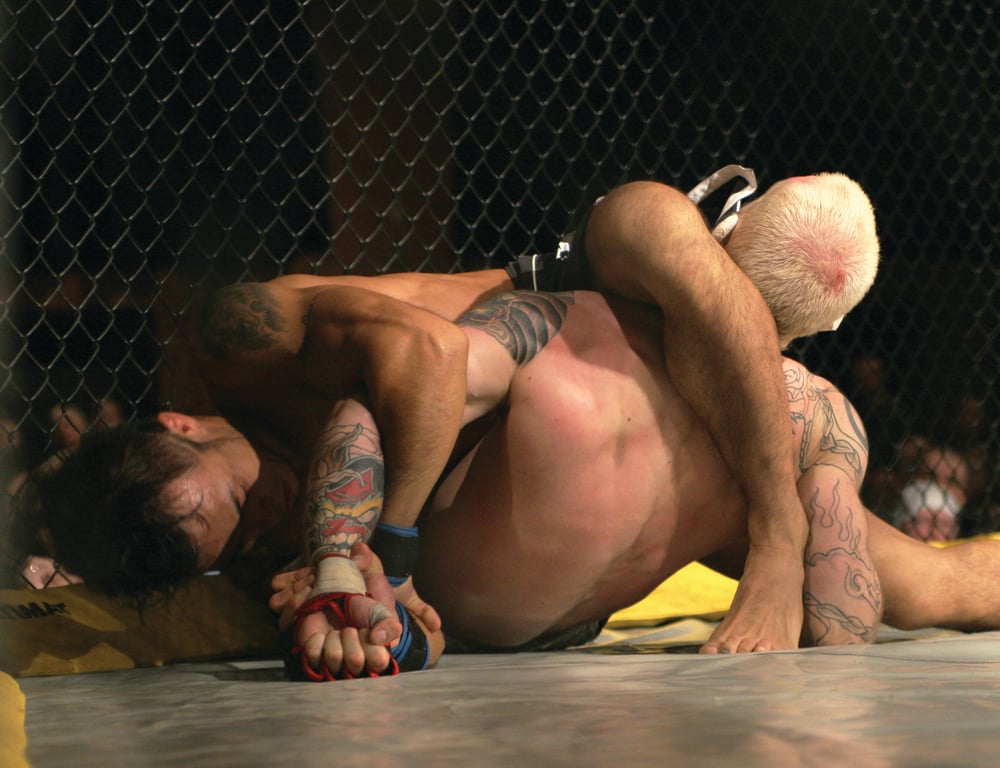
Issue 022
February 2007
By Rosi Sexton
Last month we went through the details of the straight armlock and its effects on the elbow joint. This issue we examine another major area of submissions: the bent armlock. To do this, we will need to take a look at the anatomy of the shoulder.
There are essentially two ways to apply a bent armlock: with the forearm pointing upwards or with the forearm pointing downwards. There are numerous variations on each of these, but for simplicity I will refer to the former as keylocks and the latter as kimuras.
The shoulder, like the elbow, is not a single joint but is made up of several different articulations. All are crucial for normal shoulder function, but the one that is of most interest to us here is the glenohumeral (GH) joint. This is the ball and socket joint between the shoulder blade (scapula) and the upper arm (humerus). The head of the humerus fits like a ball into the socket of the glenoid fossa on the shoulder blade.
The GH joint is a highly mobile joint. In order to achieve this mobility, some stability has to be sacrificed: the socket is notoriously shallow, and its ligaments don’t provide the same heavy duty support as found in the more stable hip joint. Instead, the shoulder relies on its muscles to keep it together. In particular, the muscles that make up the rotator cuff act as dynamic ligaments which are essential to the integrity of the shoulder.
The rotator cuff consists of four muscles that go from the shoulder blade to the humerus and encircle the GH joint. They are responsible for holding the head of the humerus in the correct position relative to the shoulder blade. In addition to their stabilising function, three of them also rotate the upper arm – the two on the back of the shoulder blade (infraspinatus and teres minor) rotate the arm outwards in the direction of a keylock, and the one buried deep on the inside of the shoulder blade (subscapularis) rotates it inwards, in the direction of the kimura.
One of the main effects of a bent armlock is to overstretch.these muscles. In applying a keylock the shoulder is forcefully rotated outwards, and the inward rotators, including subscapularis, are stretched and eventually torn. The reverse happens during a kimura. The shoulder is rotated inwards, and it is the infraspinatus and teres minor that are damaged if it is taken too far.
If the lock is applied quickly or with a lot of force, or if these muscles are weak to begin with, then the rotator cuff is unable to fulfil its stabilising function. In this case, the pressure may force the humerus out of the glenoid fossa altogether – a shoulder dislocation. If this happens, then other structures may also be damaged, including some of the shoulder ligaments or the glenoid labrum: a ring of connective tissue attached to the rim of the glenoid fossa which deepens the socket of the joint and acts as an important attachment for muscles, ligaments and joint capsule. This may also happen with a partial dislocation (subluxation) where the humerus is forced partway out of the socket, and may then spontaneously relocate (“pop back in”). Of the two bent armlocks, the keylock caries the greater risk of dislocation.
Although in most people of average shoulder flexibility keylocks and kimuras are chiefly shoulder locks, they may also affect the elbow joint. The keylock in particular may stress the medial collateral ligaments of the elbow. If you hold your arms straight out and palm up in front of you, this ligament runs down the inside edge of the elbow joint from the humerus of your upper arm to the ulna of your forearm. The stress on the elbow is made greater if when applying the lock the attacker turns the wrist so that their opponent’s palm faces away from their head, ensuring that these ligaments are stretched to the maximum.
All submissions are about either threatening or causing damage to the body in some way. Occasionally you see rare injuries which demonstrate that with all submissions, the precise nature of that damage can depend very much on the person’s individual anatomy. For example, I am aware of a couple of instances where a quickly applied kimura has resulted in a fracture of the humerus. This is unusual; although these locks apply some stress to all the bones of the arm, they are very rarely the weakest link.
If you are unlucky enough to suffer from a bent armlock that has been a little too enthusiastically applied, then as always correct aftercare and rehabilitation are crucial for making a good recovery. R.I.C.E. (rest, ice, compression, elevation) should be applied as soon as possible after the injury, preferably within the first five to ten minutes.
Rotator cuff damage can cause long-term shoulder problems if not properly addressed. Weakened muscles, or tight muscles full of scar tissue, can cause an imbalance that will affect the positioning and movement of the joint. Significant trauma to the shoulder, such as a shoulder dislocation or subluxation can also result in shoulder instability, making the joint more susceptible to dislocation in the future. Rest alone is often not enough to get the best possible recovery and prevent ongoing problems; rehabilitation is essential. As always, this is best done in consultation with a physiotherapist or other qualified professional.
...











